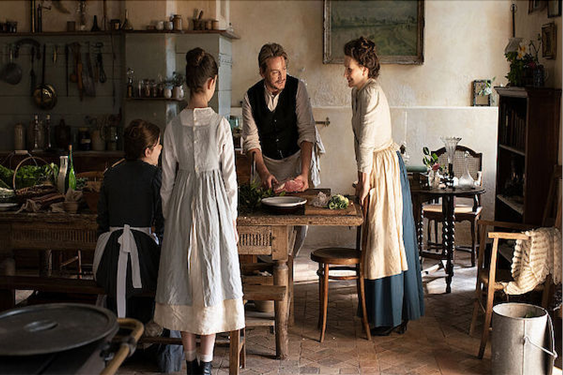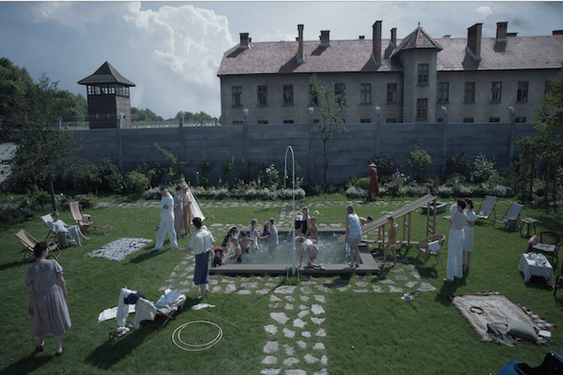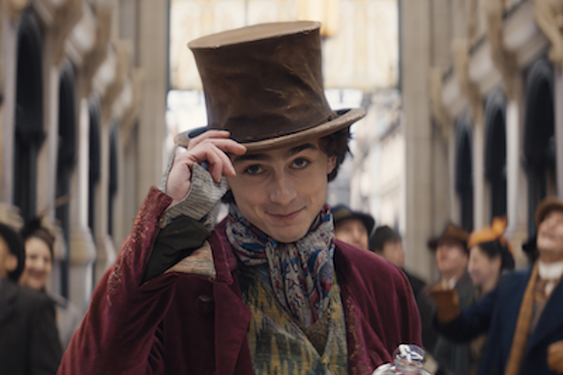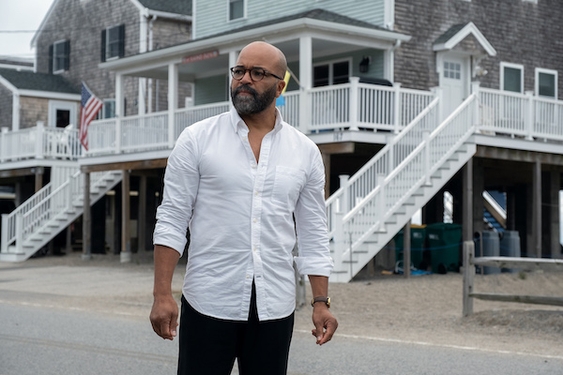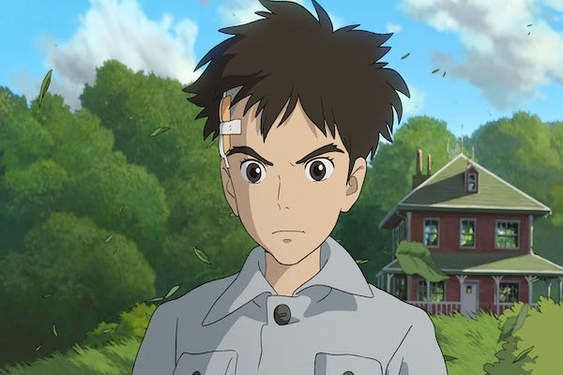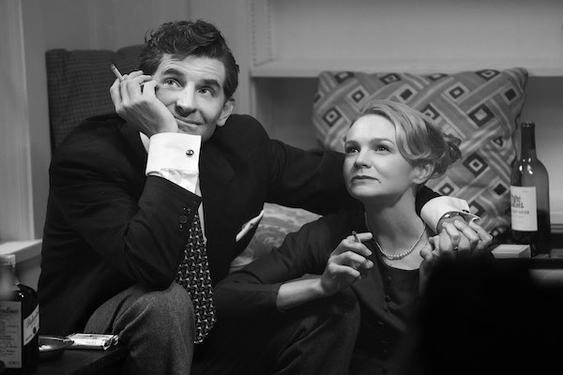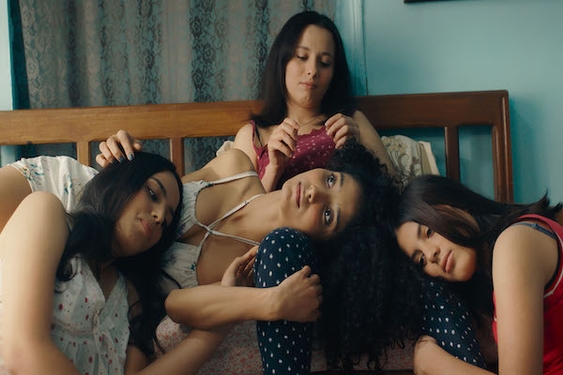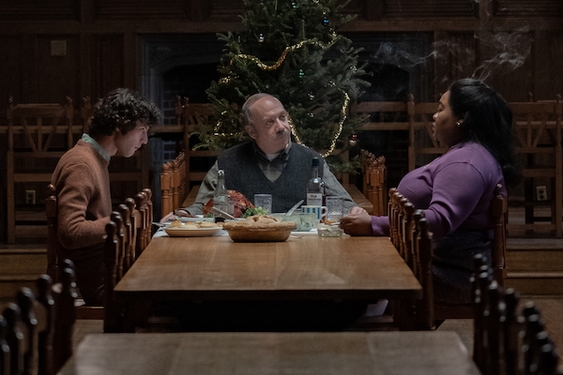Write a few sentences about the chef’s-kiss digital restoration of “Stop Making Sense” and you start sounding like you work for A24, the distributor of this 40th-anniversary edition. The film’s brilliantly detailed and newly finessed sound mix isn’t as good as live, or even better than live. It’s better than better than live.
There, see? Writing like a shill. But it’s an unexpectedly emotional experience, seeing and hearing this luminous source of happiness again. David Byrne, now 71 and the founding member of the new wave band Talking Heads, is the main show and, in some ways, his own show. Perhaps this film was the closest he ever came with these key collaborators in making it a team effort, even though he was the singular frontman.
Director Jonathan Demme’s 1984 concert film captured and distilled, into roughly 80 minutes minus credits, a three-show run of Talking Heads performances filmed live at the Pantages Theatre in Los Angeles. When I first saw “Stop Making Sense” in my early 20s I’d heard a handful of Talking Heads songs, the ones on the radio: “Psycho Killer,” “Once in a Lifetime,” “This Must Be the Place” and “Take Me to the River.” The rest was undiscovered country. So the impact of the movie, and all its bracing, eccentric, exhilarating music, combined with a great director’s natural instincts for serving that music, could barely be processed in one viewing. I saw it a lot that year.
We talk about concert movies as time capsules, and I’m not sure that phrase applies here. Some concert movies — “Woodstock” for example — work as time capsules both for what they bottled from history (hippies, squares, mud, Hendrix, homefront life during wartime) and for how the visual strategies of the filmmaking (split screen for days) relate to their specific time and place. “Stop Making Sense” has some time-capsule elements, certainly. The synthesizer keyboard fills and the Tom Tom Club interlude are purely of their moment, though no less pleasing for that.
As a visual musician, Byrne pointed to where he’d been and where he was going. He drew from a deep well of 1970s and early ‘80s experimental theater, performance and graphic-design influences, bubbling up from Lower Manhattan. Byrne gave all that a beat you could dance to. And the way he danced to it, literally, remains inspirational for countless oddballs out there, trying to get their limbs moving on the dance floor in human or at least humanoid fashion.
The movie is the finest imaginable version of the Talking Heads’ Speaking in Tongues tour. The concert’s physical staging elements, introduced in pieces and segments, with elegant and wryly suggestive words (Star Wars, Drugs, Onions, etc.), create an aura of pristine unease. Sometimes Byrne messes around with a floor lamp, creating distorted shadows on the screen behind the band. And when Bryne exits the stage and reappears, dancing, in his legendary Big Suit — “more of an architectural project than a clothing project,” its designer Gail Blacker once called it — the sharply angled sihouletted outline appears first, as if he had just strolled down the ramp of the “Close Encounters” mother ship.
All of which makes “Stop Making Sense” sound not like a rock concert at all. “Rock” isn’t quite it, anyway. What Byrne and his cohorts created at this summit of their too-brief time as a unit worked from an amalgamation of new wave, funk, world music and whatever “art rock” meant. The result was brilliant. And when it wasn’t brilliant, it was never less than arresting or unaccountably funny — I write this as someone who asks himself “How do I work this?” roughly 12 times a day on average — or plaintive and moving enough to pierce the heart, no matter how naive the melodic line. Not for nothing is “This Must Be the Place” subtitled “Naive Melody.” It’s a pearl of a song about home, and where to find it, whether it’s a house or another human.
“Stop Making Sense” also is a masterclass in the slow build. First, it’s Byrne, alone, with a boombox, on “Psycho Killer.” Hearing the lyrics again this time, it strikes you: By Byrne’s definition — “tense and nervous,” “can’t relax,” you start a conversation and “you can’t even finish it” — everyone in America is a potential psycho killer, at least on bad days.
The musicians and singers and stage risers and scenic elements then make their entrances, gradually, so that when the entire band comes together, the movie takes off and never stops stopping making sense as a concert film that knows exactly what it’s doing.
Demme and his cinematographer, Jordan Cronenweth, don’t overdo anything, and they’re there essentially to make the stage production look as enticing as possible. We’re talking about a cinematographer who created the look for, among others, “Blade Runner,” so while not a lot of money was spent on this project, its supple range of light and shadow work like a spell. This, plus editor Lisa Day’s wondrously intuitive cutting. There’s never a cut when a cut isn’t demanded. Lovely long takes, spiced with formidable close-ups and medium shots letting these people do what they do so well — it sounds so easy, yet we so seldom find this level of unassuming craft in any genre.
The magic is in Demme’s serene, patient proximity to every single performer. They are Byrne; bassist Tina Weymouth, looking a little wary (Byrne, by his own acknowledgment and hers, wasn’t easy to work with); drummer Chris Frantz; keyboardist-guitarist Jerry Harrison; guitarist Alex Weir; keyboardist Bernie Worrell; percussionist Steve Scales; and, invaluably for the spirit and drive of this movie, backup singers Ednah Holt and Lynn Mabry.
“Stop Making Sense” remind us, in the end, of a few simple truths: Other than the Rolling Stones, bands don’t last forever. Sometimes, the right creative artists collaborate on something special.
And very, very occasionally, you get a movie as good as this one out of it.
———
'STOP MAKING SENSE'
4 stars (out of 4)
MPA rating: PG (for brief suggestive material)
Running time: 1:28
How to watch: Now in IMAX theaters and in other theaters Sept. 29
———
©2023 Chicago Tribune. Visit chicagotribune.com. Distributed by Tribune Content Agency, LLC.



